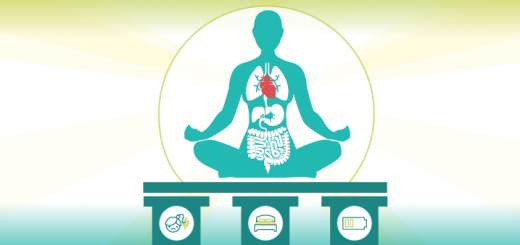What is prana and why we need to harness it
7In yoga, breathing is closely linked with the concept of prana, or life force. Prana is said to be the force that animates all living things. Prana is a manifestation of all energy. As humans, we replenish our prana through food, air and experiences. Once we learn how to understand and guide our own prana, there will be no limits to our powers. Swami Vivekananda, who brought yoga to the West, writes: “Every part of the body can be filled with prana, the vital force; and when you are able to do that, you can control the whole body. All the sickness and misery felt in the body will be perfectly controlled.”(1) This is why the original goal of asana (yoga postures) was to be prana pumps, to direct vital energy and attention to different parts of the body. This is why breath is an essential part of the yoga practice, because breath is a vehicle of prana. This is why pranayama is a fundamental part of the yoga practice, because its goal is to expand and harness our life force energy. Swami Vivekananda writes: “Pranayama really means controlling the motion of the lungs, and this motion is associated with the breath. […] Prana moves the lungs; the movement of the lungs draws in the air. So pranayama is not breathing, but controlling the muscular power which moves the lungs. When this prana has become controlled, then we shall immediately find that all other actions of prana in the body will slowly come under control.”(1) This is a pretty empowering statement – it shows that we can have a say in how our bodies feel and operate at the most subtle levels.
While many Eastern traditions talk about life force in some form or another and offer strategies to master it, Western scientific tradition is largely silent on the subject. One of the Western scientists that tried to comprehend and scientifically describe the concept of prana was Hungarian scientist Albert Szent-Gyorgyi, who won a Nobel Prize for his work on vitamin C. He was interested in understanding the process of breathing on molecular level. How did life gain energy from air? – he wondered.
Everything around us and within us is made up of molecules, that are made out of atoms, that are made out of subatomic particles called protons (that have positive charge), electrons (that have negative charge) and neutrons (that have no charge). At the very basic level, all matter is energy. But what differentiates living matter (humans, animals, birds and trees) from non-living matter (rocks and all other inanimate objects) is the “excitability” of electrons within living matter. The more excited electrons bounce between molecules, the more “desaturated” matter becomes and the more alive it is. This mobility of electrons defines the aliveness of matter and can be viewed as a scientific explanation of prana.
In fact, Albert Szent-Gyorgyi went as far as trying to explain how this whole process was set into motion. He theorized that at the very beginning of time, the earliest substance on Earth consisted of molecules that had weak electron receptors, so they could not easily release or accept electrons. It manifested as some sort of primordial muck, which stayed that way for millions of years. The byproduct of that muck, oxygen, had gradually accumulated in the atmosphere, and, being a strong electron receptor, began to exchange many more electrons with the muck, which evolved to become more aerobic. Once that process got going, it created a surplus of energy that quickly evolved into plants, insects and other organisms.
This theory is very reminiscent of how the Vedas (the oldest scriptures of Hinduism) describe the origins of life in general, although they use more poetic terms. Here is how Swami Vivekananda summarizes it: “According to the philosophers of India, the universe is composed of two entities, one of each they call akasha, and the other, prana. […] At the beginning of a cycle, prana sleeps in the infinite ocean of akasha. This ocean exists motionless in the beginning. Then arises motion of the akasha by the action of prana; and as this prana begins to move, to vibrate, out of this ocean come the various celestial systems–suns, moon, stars–the earth, human beings, animals, plants, and the manifestations of all the various forces and phenomena. Every manifestation of energy, therefore, according to the Hindus, is prana. Every manifestation of matter is akasha. “

The ancient philosophers of India knew nothing about electrons or their excitability, but they were able to explain the origin of life in a very similar way, although in their own terminology. This is possible because, according to the ancients, once you truly grasp the nature of prana in your own body, the same principles will apply to prana everywhere else. Once your grasp the interplay of energy and matter within your own organism, you will be able to see how it manifests everywhere else. Swami Vivekananda writes: “The yogis say that behind this particular manifestation there is a generalization. Behind all particular ideas stands a generalized, abstract principle. Grasp it and you have grasped everything. Just as this whole universe has been generalized, in the Vedas, into that one Absolute Existence, and he who has grasped that Existence has grasped the whole universe, mental and physical. He who has controlled prana has controlled his own mind and all the minds that exist. He who has controlled prana has controlled his body and all the bodies that exist, because prana is the source of energy.”(1)
Viewed through this lens, the famous quote “Be the change you wish to see in the world” by Mahatma Gandhi takes on a whole new meaning. By learning to understand, control and direct our own prana, we can, theoretically, affect the energy of everybody and everything all around us. Swami Vivekananda explains: “Each man must begin where he stands, must learn how to control the things that are nearest to him. This body is very near to us, nearer than anything in the external universe; and the mind is nearer than the body. But the prana which is working this mind and this body is the nearest. It is a part of the prana that moves the universe. In the infinite ocean of prana, this little wave of prana which represents our own energies, mental and physical, is the nearest to us. If we can succeed in controlling that little wave, then alone can we hope to control the whole of prana.”(1)
Even if mind control of other people is not on your agenda, wouldn’t it be nice if we could raise the overall positive vibration of our community and society? This means that we need to spend time and effort trying to understand how our energy and physiology work, and then we will be able to grasp (and affect) other manifestation of prana around us. This is why the yoga tradition has developed elaborate systems for harnessing and controlling different aspects of prana flow. Next time we will feature an overview of different models of prana flow and what they are meant to accomplish – tune in!
[jetpack_subscription_form]
References
- The Yoga and Other Works by Swami Vivekananda
- Breath: The New Science of a Lost Art by James Nestor
- Introduction to a Submolecular Biology by Albert Szent-Gyorgyi




















I am always truly impressed at how thoughtful and thorough your pieces are. I learn several things every time. Thank you!
Really enjoyed this article, Olga. As always, love your mix of Eastern and Western ideas and philosophy.
I enjoyed how you approached this subtle subject.
I look forward to seeing your take on the different movements of prana…
Thank you for sharing your studies and the connections resulting from a careful and intuitive analysis. ?
Thank you so much for your clear and informative readings. Always interesting,
I follow them regularly!
Beautifully and thoughtfully put. Thank you.
Thanks for these words. I felt excited and hopeful and look forward to more information Olga.